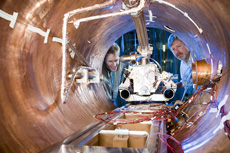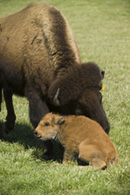|
Tue., May 22
3:30 p.m.
DIRECTOR'S COFFEE BREAK - 2nd Flr X-Over
4:00 p.m.
Accelerator Physics and Technology Seminar - 1 West
Speaker: C. Drennan, Fermilab
Title: System Overview for the Multi-Element Corrector Magnets
and Controls for the Fermilab Booster
Wed., May 23
11:00 a.m.
Fermilab ILC R&D Meeting - 1 West
Speaker: A. Hocker, Fermilab
Title: Status and Progress of the ILC Cavity Horizontal Test System (HTS)
3:30 p.m.
DIRECTOR'S COFFEE BREAK - 2nd Flr X-Over
4:00 p.m.
Fermilab Colloquium - 1 West
Speaker: B. Atwood, University of California, Santa Cruz
Title: Physics and the Violin
Click here for NALCAL,
a weekly calendar with links to additional information. |
Tuesday, May 22
- Tomato bisque
- Lemon pepper club
- Burgundy beef tips
- Smart Cuisine: tortellini alfredo
- Grilled chicken caesar wrap
- Assorted pizza slices
- Rio Grande taco salads
*Carb Restricted Alternative
Wilson Hall Cafe Menu |
|
Wednesday, May 23
Lunch
- Blackened catfish fillet
- Dirty rice
- Broccoli w/ lemon zest
- Pecan chocolate tart
Thursday, May 24
Dinner
- Tomatoes, fresh mozzarella & basil Salad
- Grilled halibut w/ spicy pimiento sauce
- Spinach risotto
- Julienne of multicolored pepper
- Pears & hazelnut soufflé
Chez Leon Menu
Call x4598 to make your reservation. |
|
|
Fermilab's new Horizontal Test Stand to test first cavity
 Andy Hocker, left, and Elvin Harms peer into the Horizontal Test Stand chamber.
Andy Hocker, left, and Elvin Harms peer into the Horizontal Test Stand chamber.
The newest resident in Fermilab's Meson Detector Building will soon be up and running. Last week, Fermilab scientists installed a nine-cell 1.3 GHz TESLA-style cavity into a cryostat in order to commission the new Horizontal Test Stand. Designed to test both 3.9 Ghz and 1.3 Ghz 9-cell niobium cavities, the Horizontal Test Stand will play an important role in the growing ILC R&D programme at Fermilab.
When a cavity makes it to the horizontal test stand, it has already jumped a bunch of hurdles, indicating that it is worthy of taking one step closer to becoming part of the actual accelerator. In order to qualify for the Horizontal Test Stand, the cavity first gets tested in the Vertical Test Stand, located in Fermilab's Industrial Building. After a cavity passes the vertical test, it gets welded inside a helium vessel and dressed with a power coupler and tuner - a process that can be time consuming and reserved only for cavities that are more likely to meet performance goals. "When a nine-cell bare cavity becomes a fully dressed cavity, you suddenly have something quite different that requires another test to see how it will now perform," says Fermilab physicist Andy Hocker. This time, however, the cavity gets tested horizontally with high power RF inside a cooled cryostat, in order to mimic the conditions inside the accelerator, only without the beam.
In Fermilab's Horizontal Test Stand, approximately 300 kW (kilowatts) of RF power will get switched on for about 1.5 ms (milliseconds) at a time and repeat five times per second, the same way that the ILC will operate. As opposed to the vertical tests, which use lower power CW (continuous wave) RF, the horizontal test applies a much larger pulsed RF power to the cavity. "This is the first time that the cavity will experience the pulsed RF power that will be similar to the conditions inside the ILC," says Fermilab ILC Director Bob Kephart.
When testing, the cavity first undergoes RF processing, a procedure where physicists apply high power RF to blast away any lingering impurities. Similar to a stress test, physicists then apply as much power to the cavity as possible before it quenches, or fails, to see just how much it can tolerate. For the ILC cavities, the target is to reach an accelerating gradient of 35 mv/m (megavolts per metre) and a Q (quality) factor of 1010. A lower Q factor will indicate that the cavity is losing power and thus not fully efficient. The tuner motor and other components also get tested while inside the Horizontal Test Stand, giving the cavity a thorough exam before it can graduate and become part of a cryomodule.
Fermilab will start testing 3.9 GHz cavities built for DESY's TTF/FLASH accelerator in the Horizontal Test Stand later this spring. The goal is for each test to take approximately ten days, although Fermilab expects that the first few tests will take two to three times longer due to start-up learning curves.
Andy Hocker will update progress on the Horizontal Test Stand in a talk at 11:00 a.m. Wednesday in One West.
-- Elizabeth Clements
|
CALL TO ACTION!
Help symmetry magazine compile a physics life list
 |
| Bison and baby born this year. |
Bird watchers have life lists of sightings. We think fans of particle physics need a checklist of their own, full of not-to-be missed places, experiences, and artifacts: Fermilab's newborn baby buffalo; America's longest building, at SLAC; the six places in the bowels of the Large Hadron Collider where you can stand with one foot in Switzerland and the other in France; a hand-held prototype of the first cyclotron built by E.O. Lawrence, on display at Berkeley Lab. If Einstein's wig or Newton's false teeth existed, we'd throw them in, too.
And so we announce the particle physics life list, which will appear in an upcoming issue of symmetry. You probably have some secret gems of your own to add. Email us your entries for consideration with subject line "Life List." Contributors will be acknowledged in an upcoming issue of symmetry.
--symmetry editorial staff
|
From American Institute of Physics, May 18, 2007
FY 2008 Appropriations Cycle Starts on a Promising Note
The House and Senate have agreed on an FY 2008 budget plan that they describe "provides significant increases for NSF and the DOE Office of Science, and fully funds the President's 2008 request for NASA at $17.3 billion." The "Concurrent Resolution on the Budget for Fiscal Year 2008" was adopted yesterday in both chambers on a largely party line vote, and sets the stage for the appropriators to begin writing their funding bills.
A budget resolution sets spending parameters to guide appropriators. Since it also sets broad revenue (tax) objectives, it can be difficult to craft a plan that both the House and Senate agree upon. Last year (and two other years in the last five years), Congress failed to adopt a budget resolution, an early sign of the eventual failure of that Congress to pass almost all of the FY 2007 appropriations bills. The new House and Senate leadership made passage of the FY 2008 resolution a priority. The resolution, S Con Res 21, is non-binding, and does not need to be sent to President Bush for his signature.
Read more
|
|
|
Fermilab and Argonne combine strengths
 Key Fermilab and Argonne employees attended a collaboration meeting on Friday, May 18.
Key Fermilab and Argonne employees attended a collaboration meeting on Friday, May 18.
Last Friday afternoon over 50 scientists from Fermilab and Argonne National Laboratory, including both laboratory directors and many leaders of the laboratories' programs, came together for a second meeting to explore opportunities for collaboration. The opportunities to enhance the programs of our two laboratories and bring more value to the DOE programs and our user communities are enormous.
The two laboratories have remarkable strengths in science and technology that are often complementary. They are the two geographically closest national laboratories among the DOE Office of Science labs. From the center of the Tevatron to the center of the Advanced Photon Source is a mere 16.2 miles as Google Earth flies. With a combined workforce of 5000 employees and more than 6000 users, and a combined budget not far from a billion dollars, these two labs represent an enormous concentration of national scientific and technological resources in our northeast corner of Illinois. The two directors have a commitment to work together, and they report to the same boss, Robert Zimmer, President of the University of Chicago. The expectations are high and were palpable at our meeting.
Both laboratories have strengths in the accelerator arena with world-class facilities like the Tevatron and neutrino beams at Fermilab, and the APS, ATLAS Accelerator and IPNS at ANL. We also have ambitious plans for the future with RIA and the APS upgrade at ANL, and the ILC and future intense neutrino beams at Fermilab. Of special note is our growing collaboration on the ILC, a machine for which the combined strength of the two laboratories provides a strong base for hosting a global project and acting as a center for both national and international collaboration. The newly created Accelerator Institute at ANL and the Accelerator Physics Center at Fermilab will serve as foci for our collaborations.
The meeting was preceded by working group meetings in four different areas:
- the development of super conducting RF technology, including material and surface sciences, for nearly all future accelerator projects;
- the development of detector technology for particle physics, particle astrophysics (including bolometric detectors) and photon sciences;
- cosmology and particle astrophysics where the combination of strengths at the University of Chicago, Fermilab and ANL are unequaled; and
- the development of an education program that exploits the high concentration of accelerator expertise to train the next generation of accelerator physicists.
At the plenary session we heard reports from the working groups and we discussed additional areas of collaboration, including the use of massive computational resources as are expected to be developed at ANL for accelerator simulation, astrophysical modeling and lattice gauge calculations.
We all noticed the increased momentum since our first meeting at ANL and look forward to much progress across a broad front by the fall meeting of our laboratories.
|
|
Scottish Country Dancing
Scottish Country Dancing will meet Tuesday, May 22, at Kuhn Barn on the Fermilab site. Instruction begins at 7:30 p.m. and newcomers are always welcome. Most dances are fully taught and walked through, and you do not need to come with a partner. The group will move to Ramsey Auditorium for the summer beginning June 12. Call (630)840-8194 or (630)584-0825 or email for more information.
More Mathematica 6 sessions scheduled
"What's New in Mathematica 6?" will take place on June 4 from 9:30-11:30 a.m. or 1:00-2:30 p.m. The seminar will display and explain the new visualization power and the
dynamic capabilities new to Mathematica 6. Other topics will include high performance computing and gridMathematica. There is no cost for this
seminar or the following training. Learn more and enroll.
"A Brief Introduction to Mathematica 6" will take place on June 4 from 12:30 p.m. - 2:30 p.m. or 3:00 p.m.-5:00 p.m.
This class will provide direct experience with all of the basic features of
Mathematica 6, as well as a foundation for developing advanced applications
of the system. Learn more and enroll.
Wisconsin Dells discount book sale
If you are planning a trip to the Dells, don't miss out on more than 150 discount coupons
for lodging, food, entertainment, shops and activities. The book expires
December 2007. The book normally sells for $25.00 but our cost is $20.25.
Stop by the Recreation Office and look at what the book has to offer.
Fermilab Basketball League
Join the Fermilab Basketball League for the summer season. Summer students play for half price! The season starts on May 24 and games are held on Thursday evenings at 5:15 p.m. & 6:15 p.m. at the Rec Center. If you are interested, please contact Ryan Schultz by phone (x6571) or by email. Information, schedule, rules, etc. can be found online. Family members (husbands, sons) are eligible. Current Recreation Facility membership required to participate.
Upcoming Activities |
|


